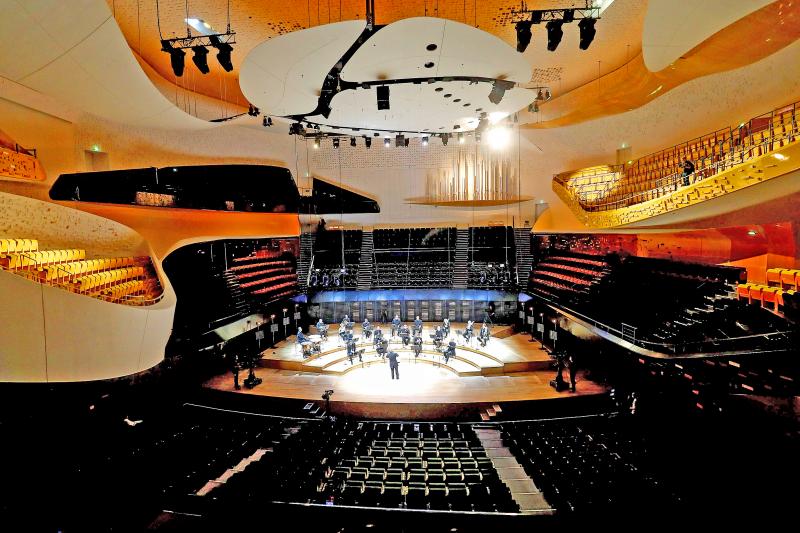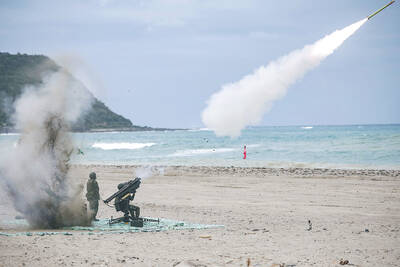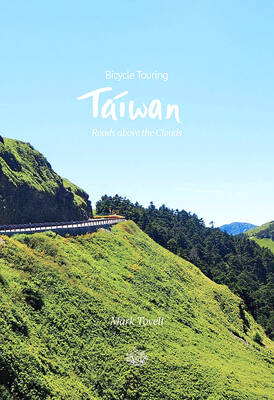Declan Costello, an ear, nose and throat surgeon with an interest in voice disorders and a side career as a tenor, is looking back on the year.
“Six months ago, if you’d said, ‘You’re not going to be doing any clinical work or singing, and your mates who are professional singers are going to be driving Tesco vans instead, and you’re going to be in an orthopedic theater on a Sunday morning watching flutes being played into funnels,’ I would have thought you were mad.”
Early in the year, Costello also learned “some rudimentary intensive care skills” and developed and crowdfunded a novel piece of PPE to shield healthcare workers from infection during the intubation process.

Photo: AFP
But that is a story for another day.
On this particular Sunday morning early this month we are indeed in an operating theater, in a London clinic, dressed in scrubs. No one’s on the operating table, though. Instead, Sue Thomas, a flautist and piccolo player with the London Philharmonic, is playing Happy Birthday into devices that are measuring the size and number of droplets and aerosol particles she generates. Around her hover similarly dressed researchers led by aerosol specialist Jonathan Reid, professor of chemistry at Bristol University. As Thomas plays, they carefully reposition the funnels and take measurements.
CHOIRS AND COVID-19
All of this is to discover how dangerous singing and playing woodwind and brass instruments are in the spread of COVID-19. Serious outbreaks of the virus were linked to choirs from countries including South Korea and the Netherlands this spring. Most notable was the terrible case of a choir rehearsal in Skagit County, Washington state, on 10 March. Out of 61 attending practice, 52 people fell ill. Two died.
Given these tragic events, singing, as well as woodwind and brass playing, have been regarded as “higher risk” in England and by many other administrations. And, although professional rehearsals and outdoor performances are now allowed under strictly limited circumstances in England — somewhat lagging behind other parts of Europe — the guidelines issued for the nation earlier this month specifically forbid amateurs from “singing in groups or in front of audiences.” (The governments in Scotland and Wales have not yet published their rules for resuming the performing arts.)
Yet there is no secure, peer-reviewed data on the dangers of singing itself — taken in isolation, that is, from other potential contributors to outbreaks, such as close contact, shared drinks and snacks and poor ventilation. It is a question on which the livelihoods of professional musicians and the enjoyment of audiences depend, not to mention the wellbeing and emotional health of thousands of amateur singers in Britain.
The study that Costello has set up with Reid and other colleagues — funded by the Department of Digital, Culture, Media and Sport and sponsored by Public Health England — aims to insert some facts into the discussion. The researchers hope to publish their findings in a matter of weeks — incredibly fast by the usual standards of peer-reviewed academic publishing.
“At the moment,” says Costello, “the government are having to operate on a pretty precautionary principle. No sound science has been done in this area. They saw these clusters in choirs at the beginning of the pandemic, and, as public health experts, it was obviously their duty to make sure none of that was replicated elsewhere. So they felt they had to lock down singing. Trying to persuade them to unlock singing will be determined by what the science tells us.”
There’s even less known for sure about droplets and aerosol particles produced by woodwind and brass, bar one piece of work on the vuvuzela, and a couple of other recent studies that were neither peer-reviewed nor published in scientific journals. Costello, Reid and their collaborators hope to provide some much needed data in this area, too.
Twenty-five professional singers are being tested during the experiments, and 15 wind and brass players. The instrumentalists are also gamely singing for the researchers, doubling up as the experiment’s sample of untrained vocalists.
“I don’t mind,” says Sue Thomas before she launches into song. “I’m Welsh.”
The reason we are in an orthopedic theater is that researchers are taking advantage of its “laminar” air flow, an exceptionally clean system that helps prevent infections in a surgical setting. It means the team can be sure that every particle detected comes from the singing or playing itself, since there is nothing else floating about in the atmosphere.
Reid, a keen amateur tenor and trumpeter who would be singing in his church choir on a Sunday morning were it not for COVID-19, wryly tells me he’s heard Happy Birthday going on for 1,000 times these past weeks.
“We agonized over it,” says Costello. “It had to be known to everyone and not require sheet music; it had to have a decent range; it had to be singable in a variety of different styles because we’ve had singers from musical theater, jazz, rock and pop, soul, choral, opera. And it had to have a good mix of vowels and consonants.”
DROPLETS, BIG AND SMALL
The aim is find out how the number and size of droplets and aerosol particles generated by singing and playing compare with those produced by speaking and other forms of vocalization, such as coughing. The COVID-19 virus can be carried by the larger droplets, sometimes visible, that emit from a person’s mouth. These droplets fall to the ground within 1-2 meters, hence social distancing rules.
Aerosol, however, is made up of much smaller, invisible particles that hang about in the air until they are blown away (hence governments’ emphasis on being outdoors, or ensuring good ventilation). There is still a lack of certainty about the precise role these smaller particles play in the transmission of COVID-19, but opinion is tending towards the view that the virus could be transmitted this way.
There are high hopes that the study will result in a further unlocking of singing. Leslie East, president of the Association of British Choral Directors, says there are 40,000 choirs in Britain. For a lot of people, says East, especially the elderly, belonging to a choir is the most important thing in their life: “Choirs bind communities together.”
Singing is a lifelong practice, enjoyed by everyone from young children to those in their 90s. It’s a world in which amateur and professional cannot easily be untangled. Choruses such as the Hall?Choir in Manchester consist of amateurs who perform alongside some of the best professional orchestras in the world. Costello himself, a former choral scholar at St John’s College, Cambridge, sings professionally but is also a member of a top-flight amateur choir, the Holst Singers, which in turn is directed by one of Britain’s most respected professional choral conductors, Stephen Layton.
Katy Cooper, a soprano who also has a career as a public health consultant, sings in a professional London church choir.
“I hang my week on it,” she says. “The sense of limbo now is really devastating. Choirs are like families,” says David Crown, who conducts several, including the 110-strong Cheltenham Choral Society.
Crown had been preparing them for a performance of Rachmaninov’s haunting Vespers in Tewkesbury Abbey when lockdown came.
“Choirs are such a huge part of the musical fabric of this country,” he says. “I always say that there’s a choir for everyone, you can always find your slot.”
It’s a delicate ecology that for amateurs brings great joy — and for professionals, their livelihood. The performing arts face a long, slow emergence from the pandemic, and freelance singers a frightening and uncertain future.
The amateur scene also looks fragile. Large-scale choral societies operate by funding a professional conductor and soloists out of subscriptions paid by amateur members. A 150-member choral society, subject to ordinary social distancing and with some elderly or vulnerable members, sounds like a tricky proposition in the circumstances, even before you factor in the question of the possible risk posed by aerosol particles.
Tom Daggett is a member of the music department at St Paul’s Cathedral in London, and runs Hackney Children’s Choir. During lockdown he’s been working with 70 children a week on Zoom. But it’s not the same: fatigue is setting in. If the pandemic hadn’t struck, last week the children would have been singing a special evensong at the cathedral for a group of visiting African bishops.
“There’s a physical absence,” he says. “There’s a buzz you get from making music in a shared space.”
The stakes are high, then, for the research project. People across the UK long to sing together again. But Costello is keen to manage expectations.
“Spiritually, emotionally, physically,” he says, “singing is so important to people. The primary focus of this stage is getting people back to work — professional singers. For obvious reasons, that is the key focus.”
But it all depends on the results.
“I myself would dearly love to be able to sing again,” he says, “but in a safe way. The results of this study will be entirely objective and the process for peer review will mean that everything is open. Although I would be upset if singing were locked down even more, it’s my duty to make sure the results are as transparent as they can be. If it turns out singing is dangerous, we need to know about it.”

In late October of 1873 the government of Japan decided against sending a military expedition to Korea to force that nation to open trade relations. Across the government supporters of the expedition resigned immediately. The spectacle of revolt by disaffected samurai began to loom over Japanese politics. In January of 1874 disaffected samurai attacked a senior minister in Tokyo. A month later, a group of pro-Korea expedition and anti-foreign elements from Saga prefecture in Kyushu revolted, driven in part by high food prices stemming from poor harvests. Their leader, according to Edward Drea’s classic Japan’s Imperial Army, was a samurai

The following three paragraphs are just some of what the local Chinese-language press is reporting on breathlessly and following every twist and turn with the eagerness of a soap opera fan. For many English-language readers, it probably comes across as incomprehensibly opaque, so bear with me briefly dear reader: To the surprise of many, former pop singer and Democratic Progressive Party (DPP) ex-lawmaker Yu Tien (余天) of the Taiwan Normal Country Promotion Association (TNCPA) at the last minute dropped out of the running for committee chair of the DPP’s New Taipei City chapter, paving the way for DPP legislator Su

It’s hard to know where to begin with Mark Tovell’s Taiwan: Roads Above the Clouds. Having published a travelogue myself, as well as having contributed to several guidebooks, at first glance Tovell’s book appears to inhabit a middle ground — the kind of hard-to-sell nowheresville publishers detest. Leaf through the pages and you’ll find them suffuse with the purple prose best associated with travel literature: “When the sun is low on a warm, clear morning, and with the heat already rising, we stand at the riverside bike path leading south from Sanxia’s old cobble streets.” Hardly the stuff of your

April 22 to April 28 The true identity of the mastermind behind the Demon Gang (魔鬼黨) was undoubtedly on the minds of countless schoolchildren in late 1958. In the days leading up to the big reveal, more than 10,000 guesses were sent to Ta Hwa Publishing Co (大華文化社) for a chance to win prizes. The smash success of the comic series Great Battle Against the Demon Gang (大戰魔鬼黨) came as a surprise to author Yeh Hung-chia (葉宏甲), who had long given up on his dream after being jailed for 10 months in 1947 over political cartoons. Protagonist